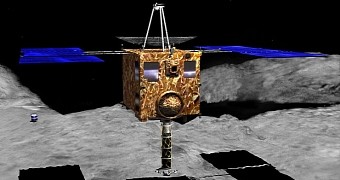Japan has some seriously big plans for the near future. In a nutshell, it wants to send a space probe to an asteroid, and have it blow up the space rock and collect and analyze bits and pieces of material resulting from the blast.
This space mission has been a long time in the making. However, it was only this past Sunday that Japanese space scientists introduced the world to the probe chosen to blast the celestial body, and shared details concerning the project.
Thus, it was revealed that the probe Japan expects to launch into space sometime later this year was dubbed Hayabusa-2. Its target is an asteroid that goes by the name of 1999JU3, which the probe should reach in about 4 years' time, Gizmodo informs.
Japanese scientists say that, after coming close to this space rock, Hayabusa-2 will first deploy a lander and three rovers. It will then use a so-called space cannon to fire a metal bullet at 1999JU3. The blast should be powerful enough to birth a crater.
Once this crater comes into being and things settle down on the surface of the asteroid, the space probe will land on 199JU3 and proceed to collect samples of material resulting from the blast. These samples should make it back to Earth by 2020.
What's interesting is that Hayabusa-2 is to mine this asteroid not in search of various types of space dust, but hoping to find organic molecules and even water. Should it succeed in pinning down such elements, the find will help scientists better understand how life emerged on Earth.
By the looks of it, 1999JU3 was chosen as the perfect target for this mission due to the fact that it is fairly easy to reach and because data collected over the years indicates that it might be carrying organic molecules and trace amounts of water.
This is not the first time Japan sets out to explore an asteroid using space probes. Thus, it was about a decade and a half ago that the country launched a probe dubbed Hayabusa and had it study the makeup of a potato-shaped asteroid by the name of Itokawa.
This probe returned to Earth in 2010 and brought with it about 1,500 grains of dust. This might sound impressive, but the truth is that these 1,500 grains of dust amount to just one-millionth of a gram. Hence, the mission was soon labeled a failure. More so since the probe was expected to mine the asteroid and collect way more space material than it did.

 14 DAY TRIAL //
14 DAY TRIAL //